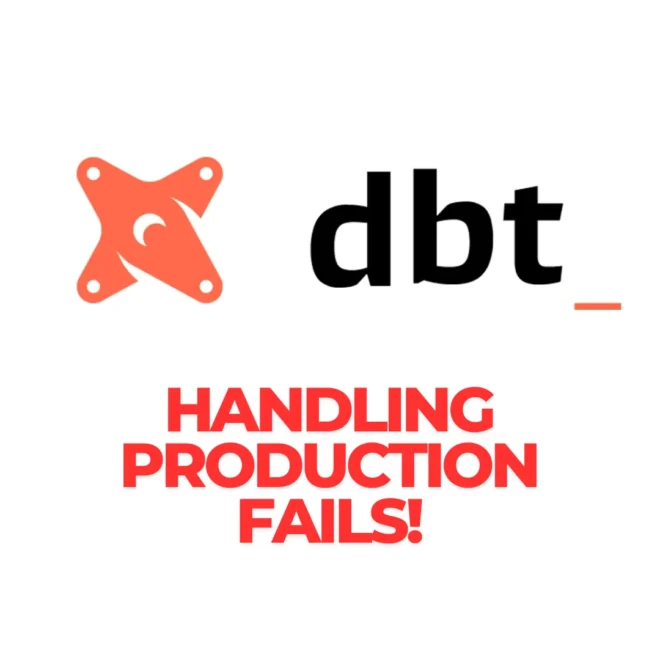A Comprehensive Guide to Debugging, Monitoring, and Prevention
When a dbt model fails during a production run, swift and effective action is crucial to maintain data pipeline integrity. By leveraging dbt’s built-in debugging tools such as --debug, and utilizing orchestration and monitoring systems like GitHub Actions, Airflow, and dbt Cloud, you can efficiently identify and resolve issues. This guide provides a step-by-step approach to managing such failures, ensuring minimal disruption to your data workflows.
Understanding the Impact of DBT Model Failures
In a production environment, a failing dbt model can halt data transformations, leading to incomplete or outdated datasets. Common causes include:
- Schema Changes: Upstream modifications that are not reflected in the model.
- Data Quality Issues: Unexpected nulls or duplicates violating model constraints.
- Resource Constraints: Timeouts or memory limitations in the data warehouse.
- Code Errors: Syntax errors or logic flaws in SQL transformations.
Step-by-Step Guide to Handling DBT Model Failures
1. Isolate the Failing Model
Use the --select flag to target the specific model:
dbt run --select model_name
This command executes only the specified model, allowing you to focus on the problematic area without running the entire project.
2. Enable Debug Mode for Detailed Logs
Activate verbose logging to gain insights into the failure:
dbt run --select model_name --debug
The --debug flag provides comprehensive logs, including database queries and error messages, facilitating quicker diagnosis.
3. Utilize Fail-Fast to Prevent Cascading Failures
In scenarios where multiple models are executed, use the --fail-fast flag to halt execution upon the first failure:
dbt run --fail-fast
This approach prevents downstream models from running with potentially corrupted or incomplete data.
4. Examine DBT Artifacts for Post-Run Analysis
After execution, dbt generates artifacts such as run_results.json, which contains detailed information about each model’s execution status:
- run_results.json: Execution outcomes, including success or failure statuses.
- manifest.json: Metadata about your dbt project, including model dependencies.
Analyzing these files can help identify patterns in failures and inform future debugging efforts.
Implementing Testing and Alerting Mechanisms
1. Incorporate DBT Tests
Define tests within your dbt models to validate data integrity:
models:
- name: orders
tests:
- unique:
column_name: order_id
- not_null:
column_name: customer_id
Running dbt test will execute these validations, catching issues before they escalate.
2. Set Up Alerting with Orchestration Tools
Integrate dbt with orchestration platforms to automate alerts:
- GitHub Actions: Trigger notifications upon job failures.
- Airflow: Define tasks that send alerts when dbt models fail.
- dbt Cloud: Configure email or Slack notifications for job statuses.
These integrations ensure prompt awareness of issues, enabling faster response times.
Leveraging Orchestration and Monitoring Tools
1. GitHub Actions for Continuous Integration
Set up workflows that automatically run dbt commands upon code changes:
name: dbt CI
on: [push]
jobs:
run-dbt:
runs-on: ubuntu-latest
steps:
- uses: actions/checkout@v2
- name: Install dependencies
run: pip install dbt
- name: Run dbt
run: dbt run --fail-fast
This setup ensures that any issues are caught during the development phase.
2. Airflow for Workflow Management
Use Airflow to schedule and monitor dbt runs, allowing for complex dependency management and retry logic.
3. dbt Cloud for Centralized Monitoring
dbt Cloud offers a user-friendly interface to manage and monitor dbt runs, providing features like job scheduling, logging, and alerting.
Best Practices for Preventing Future Failures
- Regularly Update Tests: Ensure that your tests evolve with your data models to catch new potential issues.
- Monitor Resource Usage: Keep an eye on warehouse performance to prevent resource-related failures.
- Document Model Dependencies: Maintain clear documentation of model relationships to understand the impact of changes.
- Implement Version Control: Use Git or similar tools to track changes and facilitate rollbacks if necessary.
Conclusion
Handling dbt model failures in production requires a combination of immediate debugging, robust testing, and proactive monitoring. By following the steps outlined in this guide, you can minimize downtime and maintain the reliability of your data pipelines.
FAQs
Q: How can I quickly identify which model failed?
A: Use dbt run --select model_name --debug to isolate and obtain detailed logs for the failing model.
Q: What are dbt artifacts, and how can they help?
A: dbt artifacts like run_results.json provide execution details for each model, aiding in post-run analysis and debugging.
